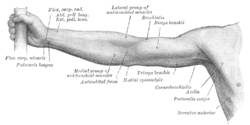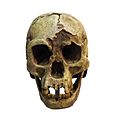The evolution of human bipedalism, which began in primates approximately four million years ago, or as early as seven million years ago with Sahelanthropus...
21 KB (2,665 words) - 14:14, 4 June 2025
Upper limb (redirect from Human Upper limb)
own body using the large curved claws on its foredigits. Human skeletal changes due to bipedalism Lower limb "Upper Extremity". MeSH. Retrieved 26 June 2011...
25 KB (2,907 words) - 13:01, 7 June 2025
comparable to other apes. Wikimedia Commons has media related to Sole (foot). Barefoot Footprint Gait (human) Human skeletal changes due to bipedalism Ross...
13 KB (1,479 words) - 08:18, 4 May 2025
the great apes. Over their evolutionary history, humans gradually developed traits such as bipedalism, dexterity, and complex language, as well as interbreeding...
266 KB (26,508 words) - 02:55, 11 June 2025
Hand (redirect from Human hand)
Finger-counting Finger tracking Handstand Hand strength Hand walking Human skeletal changes due to bipedalism Knuckle-walking Palmistry—fortune-telling based on lines...
41 KB (4,681 words) - 11:54, 8 May 2025
may have acted together to lead to human bipedalism. It is important to distinguish between adaptations for bipedalism and adaptations for running, which...
80 KB (9,599 words) - 13:49, 4 June 2025
fibers. The tissue of a skeletal muscle is striated – having a striped appearance due to the arrangement of the sarcomeres. A skeletal muscle contains multiple...
119 KB (13,832 words) - 08:08, 11 June 2025
Orthograde posture (section Morphological changes)
Schmitt D (May 2003). "Insights into the evolution of human bipedalism from experimental studies of humans and other primates". The Journal of Experimental...
13 KB (1,602 words) - 02:52, 5 May 2025
Shoulder girdle (category Skeletal system)
from gill arches present in ancient vertebrates. Shoulder Human skeletal changes due to bipedalism Physiological joints are called "false" joints because...
15 KB (1,853 words) - 02:09, 11 May 2025
Pelvis (redirect from Human pelvis)
clitoridis. Modern humans are to a large extent characterized by bipedal locomotion and large brains. Because the pelvis is vital to both locomotion and...
49 KB (6,050 words) - 17:13, 8 May 2025
came from the inefficiency of bipedalism and the growing energy costs of climbing tall trees. Human ancestors are thought to have had more muscles connecting...
12 KB (1,694 words) - 00:26, 16 October 2024
Denisovans with the early ancestors of those Eurasians. The skeletal remains of an early modern human from the Tianyuan cave (near Zhoukoudian, China) of 40...
93 KB (11,275 words) - 18:01, 9 June 2025
Obstetrical dilemma (category Human evolution)
that the head undergoes in order to travel through. Due to the evolution of bipedalism in humans, the pelvis had evolved to have a shorter, more forward-curved...
33 KB (4,465 words) - 04:08, 21 May 2025
Homo floresiensis (redirect from Human Hobbit)
evidence of its existence back to 50,000 years ago. The Homo floresiensis skeletal material at Liang Bua is now dated from 60,000 to 100,000 years ago; stone...
73 KB (7,624 words) - 04:34, 2 June 2025
for short periods and at a great expenditure of energy. The human adaption to bipedalism has also affected the location of the body's center of gravity...
75 KB (9,343 words) - 12:30, 11 June 2025
Obstructed labour (category Articles containing Ancient Greek (to 1453)-language text)
morphologically evolved to survive as bipeds, however, bipedalism has resulted in skeletal changes that have consequently narrowed the pelvis and the birth...
21 KB (2,247 words) - 15:34, 30 May 2025
Tree house (category Trees and humans)
to the speculative hypothesis that archaic humans may have lived in trees until then. The skeletal changes due to the evolution of human bipedalism started...
17 KB (1,800 words) - 10:38, 26 May 2025
Scoliosis (category Wikipedia medicine articles ready to translate)
strong selection for bipedalism. For a bipedal stance, a highly mobile, elongated lower spine is very beneficial. For instance, the human spine takes on an...
83 KB (8,644 words) - 13:59, 23 May 2025
Self-domestication (category Articles to be expanded from April 2024)
hominins. It led to rapid changes typical for domestication, such as in cranial morphology, skeletal architecture, reduction in brain volume, to playful and...
21 KB (2,422 words) - 06:06, 7 June 2025
similar to that of modern humans and other Homo, with adaptations for bipedalism and a humanlike gait. The heel bone has a low orientation, comparable to those...
56 KB (6,300 words) - 23:55, 10 June 2025
origin. His age at death has been estimated at 40 to 42 years. In 1992, alleged cut marks on the skeletal remains were reported, particularly at the edges...
29 KB (3,617 words) - 18:47, 19 February 2025
implications related to metabolism, brain function, and skeletal and muscular development. Some genes may have helped immigrating modern human populations acclimatise...
135 KB (13,674 words) - 06:09, 11 June 2025
confirmed how many other features of its skeleton reflect adaptation to bipedalism on the ground as well. Like later hominins, Ardipithecus had reduced...
30 KB (3,222 words) - 16:15, 30 April 2025
of other primates. Reduced canine size may be due to bipedalism and adaptations of the hand. Bipedalism is not a common trait, yet many species like the...
79 KB (9,029 words) - 19:59, 7 June 2025
Walking (redirect from Human walking)
chimpanzees. Chimpanzee quadrupedal and bipedal energy costs are found to be relatively equal, with chimpanzee bipedalism costing roughly ten percent more than...
56 KB (7,186 words) - 03:52, 9 June 2025
associated skeletal aspects.: 5 In 1973, the IARE team unearthed the first knee joint, AL 129-1, and showed the earliest example at the time of bipedalism. On...
68 KB (8,465 words) - 20:52, 23 May 2025
heat. When humans are exposed to certain climates for extended periods of time, physiological changes occur to help the individual adapt to hot or cold...
16 KB (1,924 words) - 00:41, 17 September 2024
traits, such as bipedalism, quadrupedalism, possessing the mandibles of a Predator, and other structural changes that enable adaptation to its new environment...
66 KB (8,643 words) - 10:47, 7 June 2025
bipedalism, relatively small jaws and teeth (indicating a major change in diet) as well as body proportions and inferred lifestyles more similar to modern...
73 KB (9,274 words) - 15:27, 12 June 2025
("Neandersovans"). The dispersal of H. erectus is generally ascribed to the evolution of obligate bipedalism, better technology, and adoption of a carnivorous diet...
74 KB (8,033 words) - 00:22, 29 May 2025

























